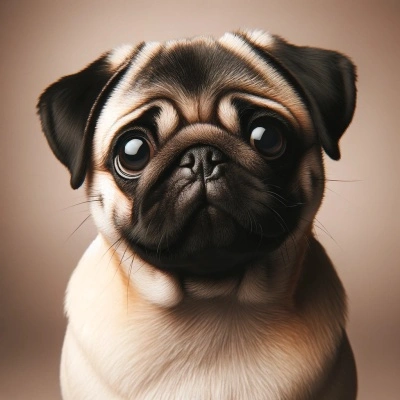Beyond Black and Fawn: The Unseen Spectrum of Rare Pug Colors

Pugs, a breed known for their distinctive wrinkled faces and charming demeanor, come in a variety of colors. While some hues like fawn and black are commonly seen, several other shades are far less common. These unique colors, ranging from silver to apricot, not only enhance the breed’s visual appeal but also contribute to its popularity. In exploring these rare color variations, one gains insight into the genetic diversity and breeding practices that shape this beloved breed.
I. Introduction to Rare Pug Colors
A. Overview of Pug Breed Characteristics
The pug, a breed revered for its distinctive, expressive face and compact, muscular body, has been a beloved companion throughout history. Known for their playful yet dignified demeanor, pugs possess a charming personality that endears them to their owners. With their deep wrinkles and large, dark eyes, they exude an almost human-like expressiveness that makes each one unique.
B. Significance of Coat Color in Pugs
In pugs, the coat color does more than add to their aesthetic appeal; it is a reflection of their genetic makeup and a key aspect of their breed standard. While coat color can vary, each hue carries its unique genetic information, contributing to the breed’s diversity. These colors not only distinguish pugs visually but also play a role in breed health and temperament.
C. Overview of Common and Rare Colors in Pugs
Pugs are typically recognized in shades like fawn and black, which are common and widely accepted in breed standards. However, there exists a palette of rare colors that includes silver, apricot, brindle, and white. These rare colors, though less well-known, offer a glimpse into the genetic diversity of the breed.
II. Exploring the Spectrum of Rare Pug Colors
A. Description of Rare Colors
- Silver: Silver pugs exhibit a sleek, metallic coat that shines uniquely under sunlight. This color is a variation of the more common fawn and can range from a light grey to a deeper charcoal.
- Apricot: Apricot pugs have a warm, golden hue that gives them a soft, glowing appearance. This color is often more vibrant than the traditional fawn.
- Brindle: Brindle pugs are characterized by their distinctive striped pattern, which overlays their primary color. This striking pattern can vary greatly in prominence and color depth.
- White: White pugs are rare and captivating, with a pure, snowy coat that is both eye-catching and elegant.
B. Genetic Basis of These Colors
The unique colors found in rare pugs arise from specific genetic variations. These colors are often the result of recessive genes, which means both parents must carry the gene for the rare color to appear in their offspring. Understanding these genetic mechanisms is crucial for ethical breeding practices.
C. Rarity and its Impact on Popularity
Rare colors in pugs have a significant impact on their popularity. While some enthusiasts seek out these unique hues for their novelty, others prefer the classic colors that align with traditional breed standards. The rarity of these colors can sometimes lead to a higher demand and, consequently, a higher value in the pet market.
III. The Breeding and Health Implications of Rare Colors in Pugs
A. Breeding Practices for Rare Colors
Breeding for rare colors requires a deep understanding of genetics and a responsible approach. Breeders must ensure that they are not compromising the health and well-being of the pugs in pursuit of a specific color.
B. Health Considerations Specific to Certain Colors
Certain rare colors in pugs may be linked to specific health issues. For example, white pugs can be prone to skin sensitivities and hearing problems. Potential owners and breeders need to be aware of these associations to ensure the health of the pugs.
C. Ethical Considerations in Breeding for Color
The pursuit of rare colors must be balanced with ethical breeding practices. This includes avoiding inbreeding, ensuring genetic diversity, and prioritizing the health, temperament, and overall well-being of the pugs over their coat color.
IV. The Cultural and Historical Perspectives on Pug Colors
A. Historical Significance of Different Colors
Throughout history, certain pug colors have been favored in different cultures. For instance, in ancient China, where the pug originated, certain colors were preferred for imperial pets. The cultural significance of these colors has evolved, influencing breed standards and preferences.
B. Cultural Perceptions and Preferences
Different cultures and regions may have distinct preferences for pug colors. Historical associations, fashion trends, and the rarity of the colors often influence these preferences.
C. The Evolution of Pug Colors Through History
The range of colors seen in pugs today is a result of centuries of breeding and evolution. From their origins in China to their spread across Europe and the Americas, the pug’s color spectrum has expanded, reflecting the changing tastes and breeding practices of different eras and regions.
This exploration of rare pug colors reveals not only the beauty and diversity of the breed but also the complexities and responsibilities involved in breeding and owning these unique dogs. Understanding the genetic, health, and ethical aspects of these rare colors is essential for preserving the integrity and well-being of the breed.
V. FAQs
Q: What are the rarest colors in pugs?
A: The rarest pug colors include silver, apricot, brindle, and white. These colors are less common due to their specific genetic requirements.
Q: Can pugs have health issues related to their color?
A: Yes, certain colors in pugs can be linked to specific health issues. For example, white pugs may be prone to skin sensitivities and hearing problems.
Q: Why do some people view pugs as unattractive?
A: Perceptions of beauty vary greatly. Pugs have distinctive features like a flat face and prominent eyes, which some may find less traditionally appealing. However, many find these features endearing and full of character.
Q: Can pugs swim?
A: Pugs can swim, but they are not naturally adept swimmers due to their short snouts and compact body shape. It’s important to closely supervise pugs around water and consider a doggy life vest for safety.
Q: How does the rarity of a color affect a pug’s value?
A: Rare colors can sometimes increase a pug’s value, particularly in the pet market. This is due to the uniqueness and demand for these distinctive colors.
Q: Are there ethical concerns in breeding pugs for rare colors?
A: Yes, ethical concerns arise when breeding for specific traits, like color, overshadows the importance of health and well-being. Responsible breeding should prioritize the overall health of the pugs.
Q: How can I ensure I’m adopting a pug from a responsible breeder?
A: Look for breeders who prioritize health and temperament over appearance, are transparent about their breeding practices, and perform health screenings on their pugs.
VI. Conclusion: The Future of Rare Pug Colors
A. Trends in Pug Breeding
The future of pug breeding is likely to continue exploring rare colors but with a growing emphasis on health and ethical practices.
B. Potential Changes in Popularity and Rarity
As awareness increases, the popularity of certain rare colors may fluctuate. This could lead to changes in rarity and breeding practices.
C. Preserving the Health and Diversity of the Breed
The key to preserving pug health and diversity lies in responsible breeding practices that prioritize genetic health over color rarity.
VII. Suggested Reading
Before exploring the rich world of pugs, it’s beneficial to delve into literature that provides deeper insights into the breed. These books offer a wealth of knowledge, from breed history to care tips.
- “Pugs: From Pup to Senior” by Davis – A comprehensive guide covering the lifespan of pugs, highlighting their development from puppyhood to senior years.
- “The Pug Handbook” by Emily Wilson – An ultimate guide exploring the psychology, care, and unique aspects of pug ownership.
- “Pugs: A Photographic Journey” by David Brown – A visually stunning book showcasing the beauty and charm of pugs through captivating photography.
- “Pugs: The Ultimate Pug Lover’s Guide” by Laura Anderson – A detailed exploration of pug history, characteristics, and care, perfect for pug enthusiasts.
After immersing yourself in these readings, you’ll gain a deeper appreciation and understanding of pugs, enhancing your connection with these charming canines.






